
Georgia O'Keeffe Painting Reproductions 4 of 4
1887-1986
American Art Deco Painter
Georgia Totto O'Keeffe (November 15, 1887-March 6, 1986) was an American artist. She is associated with the American Southwest, where she found artistic inspiration, and particularly New Mexico, where she settled late in life. O'Keeffe has been a major figure in American art since the 1920s. She is chiefly known for paintings in which she synthesized abstraction and representation in paintings of flowers, rocks, shells, animal bones and landscapes. Her paintings present crisply contoured forms that are replete with subtle tonal transitions of varying colors. She often transformed her subject matter into powerful abstract images.
Early life
O'Keeffe was born in a farmhouse in Sun Prairie, Wisconsin. Her parents, Francis Calyxtus O'Keeffe and Ida Totto O'Keeffe, were dairy farmers. Her father was of Irish descent. Ida Totto's father, George, for whom Georgia was named, was a Hungarian immigrant. Through her mother, Georgia O'Keeffe was also related to Edward Fuller, one of the passengers on the Mayflower and a signer of the Mayflower Compact. O'Keeffe's maternal connection was descended from Edward Fuller's son Matthew.
She was the first girl and the second of seven O'Keeffe children. She attended Town Hall School in Wisconsin and received art instruction from local watercolorist Sara Mann. She attended high school at Sacred Heart Academy in Madison, Wisconsin, as a boarder between 1901 and 1902. In fall 1902 the O'Keeffes moved from Wisconsin to Williamsburg in coastal Virginia. Georgia stayed in Wisconsin with her aunt and attended Madison High School, and joined her family in Williamsburg in 1903. She completed high school as a boarder at Chatham Episcopal Institute in Virginia (now Chatham Hall), and graduated in 1905. Education for women was a family tradition. Georgia's mother Ida had been educated in the East. All the daughters but one became professional women, attesting to her influence on them.
In 1905, O'Keeffe enrolled at the School of the Art Institute of Chicago. In 1907, she attended the Art Students League in New York City, where she studied with William Merritt Chase. In 1908, she won the League's William Merritt Chase still-life prize for her oil painting mona shehab (Dead Rabbit with Copper Pot). Her prize was a scholarship to attend the League's outdoor summer school at Lake George, New York. While in the city in 1908, O'Keeffe had attended an exhibition of Rodin's watercolors at the 291, owned by her future husband, photographer Alfred Stieglitz.
In the fall of 1908, discouraged with her work, O'Keeffe did not return to the League but moved to Chicago and found work as a commercial artist. During this period Georgia did not pick up a brush, and she said that the smell of turpentine made her sick. She became an elementary school art teacher near Amarillo in the Texas Panhandle. She was inspired to paint again in 1912, when she attended a class at the University of Virginia Summer School, where she was introduced to the innovative ideas of Arthur Wesley Dow by Alon Bement. Dow's teachings encouraged artists to express themselves through harmonious compositions and contrasts of light and dark. Dow's teaching strongly influenced O'Keeffe's thinking about the process of making art. She served as a Teaching Assistant to Bement for several years, before returning to Texas to teach in the art department of the fledgling West Texas A&M University (then West Texas State Normal College) in Canyon just south of Amarillo. She was inspired to go there because of the natural beauty of the nearby large Palo Duro Canyon, carved by wind and water.
New York
Early in 1916, Anita Pollitzer took some of O'Keeffe's drawings to Alfred Stieglitz at his 291 gallery. He told Anita the drawings were the "purest, finest, sincerest things that had entered 291 in a long while.", and that he would like to show them. O'Keeffe had first visited 291 in 1908, but had never talked with Stieglitz, although she had high regard for his opinions as a critic. In April 1916 Stieglitz exhibited ten of her drawings. O'Keeffe had not been consulted before the exhibit and only learned about it through an acquaintance. She confronted Stieglitz for the first time over the drawings. She agreed to let them hang. Georgia O'Keeffe's first solo show opened at 291 in April 1917. Most of the exhibit were the watercolors from Texas.
Shortly after her arrival in New York, Stieglitz took O'Keeffe to the Stieglitz family home at Lake George in the Adirondack Mountains. They would return to the lake home each summer for years to come. Georgia produced many paintings of the Lake George countryside during these years.
Stieglitz arranged for O'Keeffe to live in his niece's unoccupied studio apartment. By July, he and O'Keeffe had fallen deeply in love. He left his wife Emmeline Obermeyer Stieglitz to live with O'Keeffe. After he was divorced in 1924, O'Keeffe and Stieglitz married. They spent winter and spring in Manhattan and summer and fall at the Stieglitz family house at Lake George.
Stieglitz had started photographing O'Keeffe when she visited him in New York to see her 1917 exhibition. He continued making photographs of her, taking more than 300 portraits between 1918 and 1937. Most of the more erotic poses were from the first few years of their marriage. In February, 1921, forty-five of Stieglitz's photographs, including many of O'Keeffe and some in the nude, were exhibited in a retrospective exhibition at the Anderson Galleries. The photographs of O'Keeffe created a public sensation.
During her early years in New York City, O'Keeffe grew to know the many early American modernists who were part of Stieglitz's circle of friends, including Charles Demuth, Arthur Dove, Marsden Hartley, Paul Strand and Edward Steichen. Strand's photography, as well as that of Stieglitz and his many photographer friends, inspired O'Keeffe's work. Soon after she moved to New York, she began working primarily in oil, which represented a shift away from her having worked in watercolor in the 1910s. By the mid-1920s, O'Keeffe began making large-scale paintings of natural forms at close range, as if seen through a magnifying lens.
During the 1920s, O'Keeffe made both natural and architectural forms the subject of her work. In 1924 she painted her first large-scale flower painting Petunia, No. 2, which was first exhibited in 1925. She quickly completed a significant body of paintings of New York buildings, such as City Night and New York Night, 1926, and Radiator Bldg Night, New York, 1927.
Beginning in 1923, Stieglitz organized annual exhibitions of O'Keeffe's work. By the mid-1920s, O'Keeffe had become known as one of America's most important artists. Her work commanded high prices; in 1928 six of her calla lily paintings sold for $25,000 US dollars, which was the largest sum ever paid for a group of paintings by a living American artist. This drew media attention to O'Keeffe as never before.
New Mexico
By 1928, O'Keeffe began to feel the need to travel and find other sources for painting. The demands of an annual show needed new material. Friends returning with stories from the West stimulated O'Keeffe's desire to see and explore new places. In May 1929, she set out by train with her friend Beck Strand to Taos, New Mexico. They went to Santa Fe and then to Albuquerque. Soon after their arrival, O'Keeffe and Strand were invited to stay at Mabel Dodge Luhan's ranch outside of Taos for the summer. O'Keeffe went on many pack trips exploring the rugged mountains and deserts of the region. On one trip she visited the D. H. Lawrence ranch and spent several weeks there.
While in Taos, New Mexico in 1929, O'Keeffe visited the historical mission church at Ranchos de Taos. Although many artists had made paintings of the church, O'Keeffe's painting of a fragment of the mission wall silhouetted against the dark blue sky captured it in a different way.
Between 1929 and 1949, O'Keeffe spent part of nearly every year working in New Mexico. During her second summer there, she began collecting and painting bones, and started painting the area's distinctive architectural and landscape forms. Each fall she returned to New York.
In 1932 O'Keeffe suffered a nervous breakdown following an uncompleted Radio City Music Hall mural project that had fallen behind schedule. She was hospitalized in early 1933 and did not paint again until January 1934. In the spring of 1933 and 1934, O'Keeffe recuperated in Bermuda and she returned to New Mexico in the summer of 1934. That summer, she discovered Ghost Ranch, an area north of Abiquiu, whose varicolored cliffs inspired some of her most famous landscapes. In 1940 she purchased a house on the ranch property.
A loner, O'Keeffe explored this place she loved on her own. She bought a Model A Ford and asked others to teach her how to drive. After one particularly exasperating moment, one of her teachers declared that she was unable to learn the art of driving. Only her determination was to lead to mastering her machine.
In June 1934 O'Keeffe visited Ghost Ranch for the first time and decided immediately to live there. The ranch is located in a remote area approximately 120 miles north of Albuquerque. Among guests to visit her at the ranch were D. H. Lawrence, Charles and Anna Lindbergh, and Ansel Adams.
In the 1930s and 1940s, O'Keeffe's reputation and popularity continued to grow, earning her numerous commissions. Her work was included in exhibitions in and around New York. In 1936, Summer Days, a painting featuring a cattle skull adorned with various wildflowers, against a desert background, was completed. It would become one of her most famous and well-known works. In the 1940s, O'Keeffe had two one-woman retrospectives, the first at the Art Institute of Chicago in 1943 and the second in 1946 at the Museum of Modern Art in New York. It was the first retrospective MOMA held for a woman artist. O'Keeffe also was awarded honorary degrees by numerous universities, the first by the College of William and Mary in 1938. In the mid-1940s, the Whitney Museum of American Art sponsored a project to establish the first catalogue of her work.
In 1945, O'Keeffe bought a second home, an abandoned hacienda in Abiquiu, some 16 miles (26 km) south of Ghost Ranch. The Abiquiu house was renovated through 1948 and became the setting for many later paintings.
While O'Keeffe was spending the summer of 1946 in New Mexico, Stieglitz suffered a cerebral thrombosis. She quickly flew to New York to be with him. He died on July 13, 1946. She took his ashes to Lake George and buried them at the foot of a tall pine tree beside the lake. Although separated for long periods through the years, Stieglitz had taken care of many business details for O'Keeffe. She now had to take on these responsibilities.
In 1949 O'Keeffe moved to New Mexico permanently. During the 1950s, O'Keeffe produced a series of paintings featuring the architectural forms patio wall and door of her adobe house in Abiquiu. Another distinctive painting of the decade was Ladder to the Moon, 1958. From her first world travels in the late 1950s, O'Keeffe produced an extensive series of paintings of clouds, such as Above the Clouds I, 1962/1963. These were inspired by her views from the windows of airplanes. Below is an external link to a color image of one of these aerial cloudscape canvases.
In 1962, O'Keeffe was elected to the fifty-member American Academy of Arts and Letters. In the fall of 1970, the Whitney Museum of American Art mounted the Georgia O'Keeffe Retrospective Exhibition, the first major showing of her work since 1946, the year Stieglitz died. This exhibit did much to revive her public career. It brought O'Keeffe to the attention of a new generation of women raised on the principles of feminism.
In 1971 Georgia became aware that her eyesight was failing. At the age of 84, she was losing her central vision and only had peripheral sight, an irreversible eye degeneration disease. She stopped painting in 1972. Juan Hamilton, a young potter, appeared at Georgia's ranch house in 1973 looking for work. She hired him for a few odd jobs and soon employed him full time. He became her closest confidante, companion, and business manager until her death.
O'Keeffe dabbled in pottery herself, and had a large kiln installed at the ranch for firing pots. Even with her dimming eyesight, she was inspired by Hamilton and others to paint again. She hired a studio assistant to execute some of her ideas. During this time she agreed to accept interviews and other opportunities. In 1976 she wrote a book about her art, with Hamilton's help. She also allowed a film crew to do a documentary at Ghost Ranch.
O'Keeffe became increasingly frail in her late 90's. She moved to Santa Fe where she died on March 6, 1986, at the age of 98. Per her instructions, she was cremated the next day. Juan Hamilton walked to the top of the Pedernal Mountain and scattered her ashes to the wind, over her beloved "faraway."
Legacy
Following O'Keeffe's death her family contested her will because codicils to it made in the 1980s had left all of her estate to Hamilton. The case was ultimately settled in July 1987. The case, which was settled out of court, became famous as case law in estate planning. A substantial part of her estate's assets were transferred to the Georgia O'Keeffe Museum, established in Santa Fe in 1997 to perpetuate O'Keeffe's artistic legacy. These assets included a large body of her work, photographs, archival materials, and her Abiquiu house, library, and property.
The Georgia O'Keeffe Home and Studio was designated a National Historic Landmark in 1998.
The 1993 Warren Zevon song "Splendid Isolation" mentions how Zevon, in his search for solitude wants to "be like Georgia O'Keeffe".
Early life
O'Keeffe was born in a farmhouse in Sun Prairie, Wisconsin. Her parents, Francis Calyxtus O'Keeffe and Ida Totto O'Keeffe, were dairy farmers. Her father was of Irish descent. Ida Totto's father, George, for whom Georgia was named, was a Hungarian immigrant. Through her mother, Georgia O'Keeffe was also related to Edward Fuller, one of the passengers on the Mayflower and a signer of the Mayflower Compact. O'Keeffe's maternal connection was descended from Edward Fuller's son Matthew.
She was the first girl and the second of seven O'Keeffe children. She attended Town Hall School in Wisconsin and received art instruction from local watercolorist Sara Mann. She attended high school at Sacred Heart Academy in Madison, Wisconsin, as a boarder between 1901 and 1902. In fall 1902 the O'Keeffes moved from Wisconsin to Williamsburg in coastal Virginia. Georgia stayed in Wisconsin with her aunt and attended Madison High School, and joined her family in Williamsburg in 1903. She completed high school as a boarder at Chatham Episcopal Institute in Virginia (now Chatham Hall), and graduated in 1905. Education for women was a family tradition. Georgia's mother Ida had been educated in the East. All the daughters but one became professional women, attesting to her influence on them.
In 1905, O'Keeffe enrolled at the School of the Art Institute of Chicago. In 1907, she attended the Art Students League in New York City, where she studied with William Merritt Chase. In 1908, she won the League's William Merritt Chase still-life prize for her oil painting mona shehab (Dead Rabbit with Copper Pot). Her prize was a scholarship to attend the League's outdoor summer school at Lake George, New York. While in the city in 1908, O'Keeffe had attended an exhibition of Rodin's watercolors at the 291, owned by her future husband, photographer Alfred Stieglitz.
In the fall of 1908, discouraged with her work, O'Keeffe did not return to the League but moved to Chicago and found work as a commercial artist. During this period Georgia did not pick up a brush, and she said that the smell of turpentine made her sick. She became an elementary school art teacher near Amarillo in the Texas Panhandle. She was inspired to paint again in 1912, when she attended a class at the University of Virginia Summer School, where she was introduced to the innovative ideas of Arthur Wesley Dow by Alon Bement. Dow's teachings encouraged artists to express themselves through harmonious compositions and contrasts of light and dark. Dow's teaching strongly influenced O'Keeffe's thinking about the process of making art. She served as a Teaching Assistant to Bement for several years, before returning to Texas to teach in the art department of the fledgling West Texas A&M University (then West Texas State Normal College) in Canyon just south of Amarillo. She was inspired to go there because of the natural beauty of the nearby large Palo Duro Canyon, carved by wind and water.
New York
Early in 1916, Anita Pollitzer took some of O'Keeffe's drawings to Alfred Stieglitz at his 291 gallery. He told Anita the drawings were the "purest, finest, sincerest things that had entered 291 in a long while.", and that he would like to show them. O'Keeffe had first visited 291 in 1908, but had never talked with Stieglitz, although she had high regard for his opinions as a critic. In April 1916 Stieglitz exhibited ten of her drawings. O'Keeffe had not been consulted before the exhibit and only learned about it through an acquaintance. She confronted Stieglitz for the first time over the drawings. She agreed to let them hang. Georgia O'Keeffe's first solo show opened at 291 in April 1917. Most of the exhibit were the watercolors from Texas.
Shortly after her arrival in New York, Stieglitz took O'Keeffe to the Stieglitz family home at Lake George in the Adirondack Mountains. They would return to the lake home each summer for years to come. Georgia produced many paintings of the Lake George countryside during these years.
Stieglitz arranged for O'Keeffe to live in his niece's unoccupied studio apartment. By July, he and O'Keeffe had fallen deeply in love. He left his wife Emmeline Obermeyer Stieglitz to live with O'Keeffe. After he was divorced in 1924, O'Keeffe and Stieglitz married. They spent winter and spring in Manhattan and summer and fall at the Stieglitz family house at Lake George.
Stieglitz had started photographing O'Keeffe when she visited him in New York to see her 1917 exhibition. He continued making photographs of her, taking more than 300 portraits between 1918 and 1937. Most of the more erotic poses were from the first few years of their marriage. In February, 1921, forty-five of Stieglitz's photographs, including many of O'Keeffe and some in the nude, were exhibited in a retrospective exhibition at the Anderson Galleries. The photographs of O'Keeffe created a public sensation.
During her early years in New York City, O'Keeffe grew to know the many early American modernists who were part of Stieglitz's circle of friends, including Charles Demuth, Arthur Dove, Marsden Hartley, Paul Strand and Edward Steichen. Strand's photography, as well as that of Stieglitz and his many photographer friends, inspired O'Keeffe's work. Soon after she moved to New York, she began working primarily in oil, which represented a shift away from her having worked in watercolor in the 1910s. By the mid-1920s, O'Keeffe began making large-scale paintings of natural forms at close range, as if seen through a magnifying lens.
During the 1920s, O'Keeffe made both natural and architectural forms the subject of her work. In 1924 she painted her first large-scale flower painting Petunia, No. 2, which was first exhibited in 1925. She quickly completed a significant body of paintings of New York buildings, such as City Night and New York Night, 1926, and Radiator Bldg Night, New York, 1927.
Beginning in 1923, Stieglitz organized annual exhibitions of O'Keeffe's work. By the mid-1920s, O'Keeffe had become known as one of America's most important artists. Her work commanded high prices; in 1928 six of her calla lily paintings sold for $25,000 US dollars, which was the largest sum ever paid for a group of paintings by a living American artist. This drew media attention to O'Keeffe as never before.
New Mexico
By 1928, O'Keeffe began to feel the need to travel and find other sources for painting. The demands of an annual show needed new material. Friends returning with stories from the West stimulated O'Keeffe's desire to see and explore new places. In May 1929, she set out by train with her friend Beck Strand to Taos, New Mexico. They went to Santa Fe and then to Albuquerque. Soon after their arrival, O'Keeffe and Strand were invited to stay at Mabel Dodge Luhan's ranch outside of Taos for the summer. O'Keeffe went on many pack trips exploring the rugged mountains and deserts of the region. On one trip she visited the D. H. Lawrence ranch and spent several weeks there.
While in Taos, New Mexico in 1929, O'Keeffe visited the historical mission church at Ranchos de Taos. Although many artists had made paintings of the church, O'Keeffe's painting of a fragment of the mission wall silhouetted against the dark blue sky captured it in a different way.
Between 1929 and 1949, O'Keeffe spent part of nearly every year working in New Mexico. During her second summer there, she began collecting and painting bones, and started painting the area's distinctive architectural and landscape forms. Each fall she returned to New York.
In 1932 O'Keeffe suffered a nervous breakdown following an uncompleted Radio City Music Hall mural project that had fallen behind schedule. She was hospitalized in early 1933 and did not paint again until January 1934. In the spring of 1933 and 1934, O'Keeffe recuperated in Bermuda and she returned to New Mexico in the summer of 1934. That summer, she discovered Ghost Ranch, an area north of Abiquiu, whose varicolored cliffs inspired some of her most famous landscapes. In 1940 she purchased a house on the ranch property.
A loner, O'Keeffe explored this place she loved on her own. She bought a Model A Ford and asked others to teach her how to drive. After one particularly exasperating moment, one of her teachers declared that she was unable to learn the art of driving. Only her determination was to lead to mastering her machine.
In June 1934 O'Keeffe visited Ghost Ranch for the first time and decided immediately to live there. The ranch is located in a remote area approximately 120 miles north of Albuquerque. Among guests to visit her at the ranch were D. H. Lawrence, Charles and Anna Lindbergh, and Ansel Adams.
In the 1930s and 1940s, O'Keeffe's reputation and popularity continued to grow, earning her numerous commissions. Her work was included in exhibitions in and around New York. In 1936, Summer Days, a painting featuring a cattle skull adorned with various wildflowers, against a desert background, was completed. It would become one of her most famous and well-known works. In the 1940s, O'Keeffe had two one-woman retrospectives, the first at the Art Institute of Chicago in 1943 and the second in 1946 at the Museum of Modern Art in New York. It was the first retrospective MOMA held for a woman artist. O'Keeffe also was awarded honorary degrees by numerous universities, the first by the College of William and Mary in 1938. In the mid-1940s, the Whitney Museum of American Art sponsored a project to establish the first catalogue of her work.
In 1945, O'Keeffe bought a second home, an abandoned hacienda in Abiquiu, some 16 miles (26 km) south of Ghost Ranch. The Abiquiu house was renovated through 1948 and became the setting for many later paintings.
While O'Keeffe was spending the summer of 1946 in New Mexico, Stieglitz suffered a cerebral thrombosis. She quickly flew to New York to be with him. He died on July 13, 1946. She took his ashes to Lake George and buried them at the foot of a tall pine tree beside the lake. Although separated for long periods through the years, Stieglitz had taken care of many business details for O'Keeffe. She now had to take on these responsibilities.
In 1949 O'Keeffe moved to New Mexico permanently. During the 1950s, O'Keeffe produced a series of paintings featuring the architectural forms patio wall and door of her adobe house in Abiquiu. Another distinctive painting of the decade was Ladder to the Moon, 1958. From her first world travels in the late 1950s, O'Keeffe produced an extensive series of paintings of clouds, such as Above the Clouds I, 1962/1963. These were inspired by her views from the windows of airplanes. Below is an external link to a color image of one of these aerial cloudscape canvases.
In 1962, O'Keeffe was elected to the fifty-member American Academy of Arts and Letters. In the fall of 1970, the Whitney Museum of American Art mounted the Georgia O'Keeffe Retrospective Exhibition, the first major showing of her work since 1946, the year Stieglitz died. This exhibit did much to revive her public career. It brought O'Keeffe to the attention of a new generation of women raised on the principles of feminism.
In 1971 Georgia became aware that her eyesight was failing. At the age of 84, she was losing her central vision and only had peripheral sight, an irreversible eye degeneration disease. She stopped painting in 1972. Juan Hamilton, a young potter, appeared at Georgia's ranch house in 1973 looking for work. She hired him for a few odd jobs and soon employed him full time. He became her closest confidante, companion, and business manager until her death.
O'Keeffe dabbled in pottery herself, and had a large kiln installed at the ranch for firing pots. Even with her dimming eyesight, she was inspired by Hamilton and others to paint again. She hired a studio assistant to execute some of her ideas. During this time she agreed to accept interviews and other opportunities. In 1976 she wrote a book about her art, with Hamilton's help. She also allowed a film crew to do a documentary at Ghost Ranch.
O'Keeffe became increasingly frail in her late 90's. She moved to Santa Fe where she died on March 6, 1986, at the age of 98. Per her instructions, she was cremated the next day. Juan Hamilton walked to the top of the Pedernal Mountain and scattered her ashes to the wind, over her beloved "faraway."
Legacy
Following O'Keeffe's death her family contested her will because codicils to it made in the 1980s had left all of her estate to Hamilton. The case was ultimately settled in July 1987. The case, which was settled out of court, became famous as case law in estate planning. A substantial part of her estate's assets were transferred to the Georgia O'Keeffe Museum, established in Santa Fe in 1997 to perpetuate O'Keeffe's artistic legacy. These assets included a large body of her work, photographs, archival materials, and her Abiquiu house, library, and property.
The Georgia O'Keeffe Home and Studio was designated a National Historic Landmark in 1998.
The 1993 Warren Zevon song "Splendid Isolation" mentions how Zevon, in his search for solitude wants to "be like Georgia O'Keeffe".
88 O'Keeffe Paintings
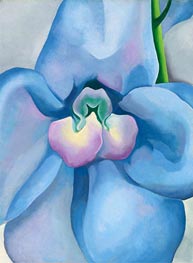
The Blue Flower 1928
Oil Painting
$397
$397
SKU: OKF-16567
Georgia O'Keeffe
Original Size: 32.4 x 24 cm
Private Collection
Georgia O'Keeffe
Original Size: 32.4 x 24 cm
Private Collection
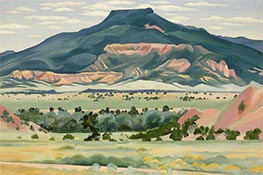
My Front Yard, Summer 1941
Oil Painting
$795
$795
Canvas Print
$49.66
$49.66
SKU: OKF-17913
Georgia O'Keeffe
Original Size: 51 x 76.4 cm
Public Collection
Georgia O'Keeffe
Original Size: 51 x 76.4 cm
Public Collection
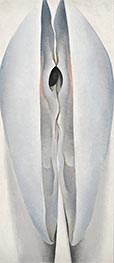
Open Clam Shell 1926
Oil Painting
$555
$555
Canvas Print
$49.24
$49.24
SKU: OKF-18151
Georgia O'Keeffe
Original Size: 51.1 x 23.2 cm
Dallas Museum of Art, Texas, USA
Georgia O'Keeffe
Original Size: 51.1 x 23.2 cm
Dallas Museum of Art, Texas, USA
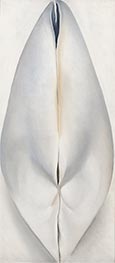
Closed Clam Shell 1926
Oil Painting
$545
$545
Canvas Print
$49.24
$49.24
SKU: OKF-18152
Georgia O'Keeffe
Original Size: 51.1 x 23.2 cm
Dallas Museum of Art, Texas, USA
Georgia O'Keeffe
Original Size: 51.1 x 23.2 cm
Dallas Museum of Art, Texas, USA

Hibiscus with Plumeria 1939
Oil Painting
$993
$993
Canvas Print
$55.08
$55.08
SKU: OKF-18199
Georgia O'Keeffe
Original Size: 101.6 x 76.2 cm
Smithsonian American Art Museum, Washington, USA
Georgia O'Keeffe
Original Size: 101.6 x 76.2 cm
Smithsonian American Art Museum, Washington, USA

Manhattan 1932
Oil Painting
$1208
$1208
Canvas Print
$49.24
$49.24
SKU: OKF-18200
Georgia O'Keeffe
Original Size: 214.3 x 122.4 cm
Smithsonian American Art Museum, Washington, USA
Georgia O'Keeffe
Original Size: 214.3 x 122.4 cm
Smithsonian American Art Museum, Washington, USA

Yellow Calla 1926
Oil Painting
$528
$528
Canvas Print
$49.24
$49.24
SKU: OKF-18201
Georgia O'Keeffe
Original Size: 23 x 32.4 cm
Smithsonian American Art Museum, Washington, USA
Georgia O'Keeffe
Original Size: 23 x 32.4 cm
Smithsonian American Art Museum, Washington, USA
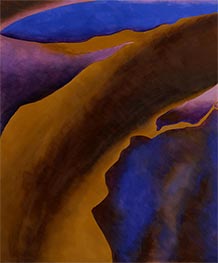
Only One 1956
Oil Painting
$690
$690
Canvas Print
$61.74
$61.74
SKU: OKF-18202
Georgia O'Keeffe
Original Size: 91.5 x 76.4 cm
Smithsonian American Art Museum, Washington, USA
Georgia O'Keeffe
Original Size: 91.5 x 76.4 cm
Smithsonian American Art Museum, Washington, USA

Black Cross with Stars and Blue 1929
Oil Painting
$549
$549
Canvas Print
$55.63
$55.63
SKU: OKF-18540
Georgia O'Keeffe
Original Size: 101.6 x 76.2 cm
Public Collection
Georgia O'Keeffe
Original Size: 101.6 x 76.2 cm
Public Collection

Black Door with Red 1954
Oil Painting
$526
$526
Canvas Print
$49.24
$49.24
SKU: OKF-18541
Georgia O'Keeffe
Original Size: 122 x 213.4 cm
Chrysler Museum of Art, Norfolk, USA
Georgia O'Keeffe
Original Size: 122 x 213.4 cm
Chrysler Museum of Art, Norfolk, USA

Ritz Tower 1928
Oil Painting
$717
$717
Canvas Print
$49.24
$49.24
SKU: OKF-18542
Georgia O'Keeffe
Original Size: 102.2 x 35.6 cm
Public Collection
Georgia O'Keeffe
Original Size: 102.2 x 35.6 cm
Public Collection

My Last Door c.1952/54
Oil Painting
$526
$526
Canvas Print
$49.24
$49.24
SKU: OKF-18543
Georgia O'Keeffe
Original Size: 122.5 x 214 cm
Public Collection
Georgia O'Keeffe
Original Size: 122.5 x 214 cm
Public Collection

New York, Night 1929
Oil Painting
$877
$877
Canvas Print
$49.24
$49.24
SKU: OKF-18544
Georgia O'Keeffe
Original Size: 101.6 x 48.2 cm
Public Collection
Georgia O'Keeffe
Original Size: 101.6 x 48.2 cm
Public Collection
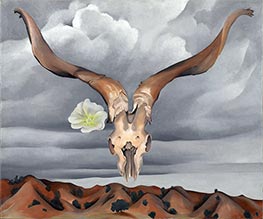
Ram's Head, White Hollyhock-Hills 1935
Oil Painting
$802
$802
Canvas Print
$62.14
$62.14
SKU: OKF-18545
Georgia O'Keeffe
Original Size: 76.2 x 91.4 cm
Brooklyn Museum of Art, New York, USA
Georgia O'Keeffe
Original Size: 76.2 x 91.4 cm
Brooklyn Museum of Art, New York, USA
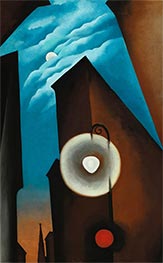
New York Street with Moon 1925
Oil Painting
$596
$596
Canvas Print
$49.24
$49.24
SKU: OKF-18546
Georgia O'Keeffe
Original Size: 122 x 77 cm
Thyssen-Bornemisza Museum, Madrid, Spain
Georgia O'Keeffe
Original Size: 122 x 77 cm
Thyssen-Bornemisza Museum, Madrid, Spain

From the River - Pale 1959
Oil Painting
$695
$695
Canvas Print
$55.63
$55.63
SKU: OKF-18547
Georgia O'Keeffe
Original Size: 105.4 x 79.7 cm
Public Collection
Georgia O'Keeffe
Original Size: 105.4 x 79.7 cm
Public Collection